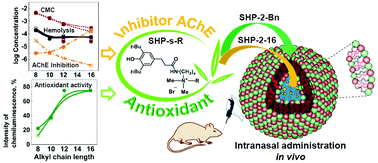Bi-functional sterically hindered phenol lipid-based delivery systems as potential multi-target agents against Alzheimer's disease via an intranasal route†
Abstract
New lipid-based nanomaterials and multi-target directed ligands (MTDLs) based on sterically hindered phenol, containing a quaternary ammonium moiety (SHP-s-R, with s = 2,3) of varying hydrophobicity (R = CH2Ph and CnH2n+1, with n = 8, 10, 12, 16), have been prepared as potential drugs against Alzheimer's disease (AD). SHP-s-R are inhibitors of human cholinesterases with antioxidant properties. The inhibitory potency of SHP-s-R and selectivity ratio of cholinesterase inhibition were found to significantly depend on the length of the methylene spacer (s) and alkyl chain length. The compound SHP-2-16 showed the best IC50 for human AChE and the highest selectivity, being 30-fold more potent than for human BChE. Molecular modeling of SHP-2-16 binding to human AChE suggests that this compound is a dual binding site inhibitor that interacts with both the peripheral anionic site and catalytic active site. The relationship between self-assembly parameters (CMC, solubilization capacity, aggregation number), antioxidant activity and a toxicological parameter (hemolytic action on human red blood cells) was investigated. Two sterically hindered phenols (SHP-2-Bn and SHP-2-R) were loaded into L-α-phosphatidylcholine (PC) nanoparticles by varying the SHP alkyl chain length. For the brain AChE inhibition assay, PC/SHP-2-Bn/SHP-2-16 nanoparticles were administered to rats intranasally at a dose of 8 mg kg−1. The Morris water maze experiment showed that scopolamine-induced AD-like dementia in rats treated with PC/SHP-2-Bn/SHP-2-16 nanoparticles was significantly reduced. This is the first example of cationic SHP-phospholipid nanoparticles for inhibition of brain cholinesterases realized by the use of intranasal administration. This route has promising potential for the treatment of AD.



 Please wait while we load your content...
Please wait while we load your content...